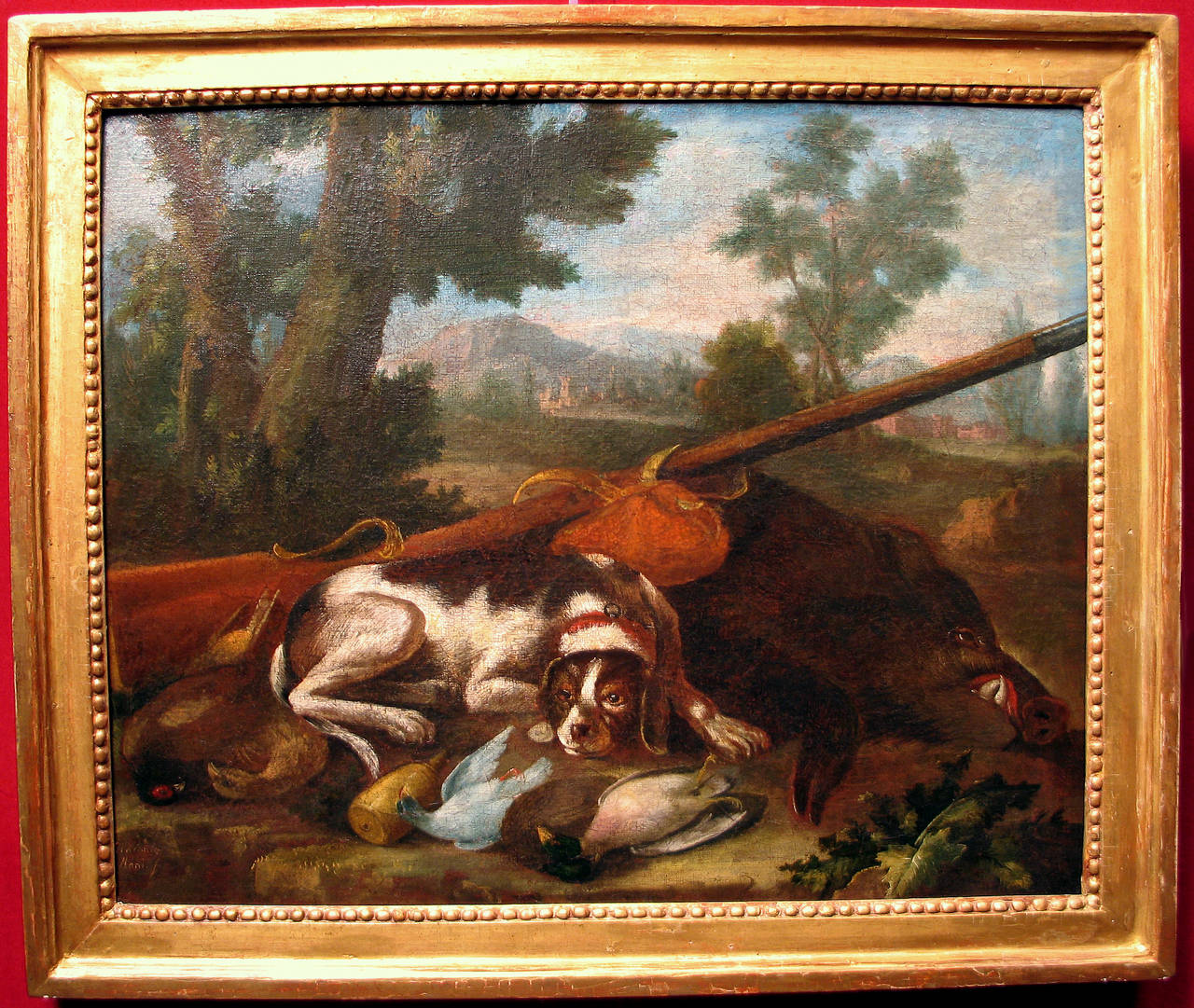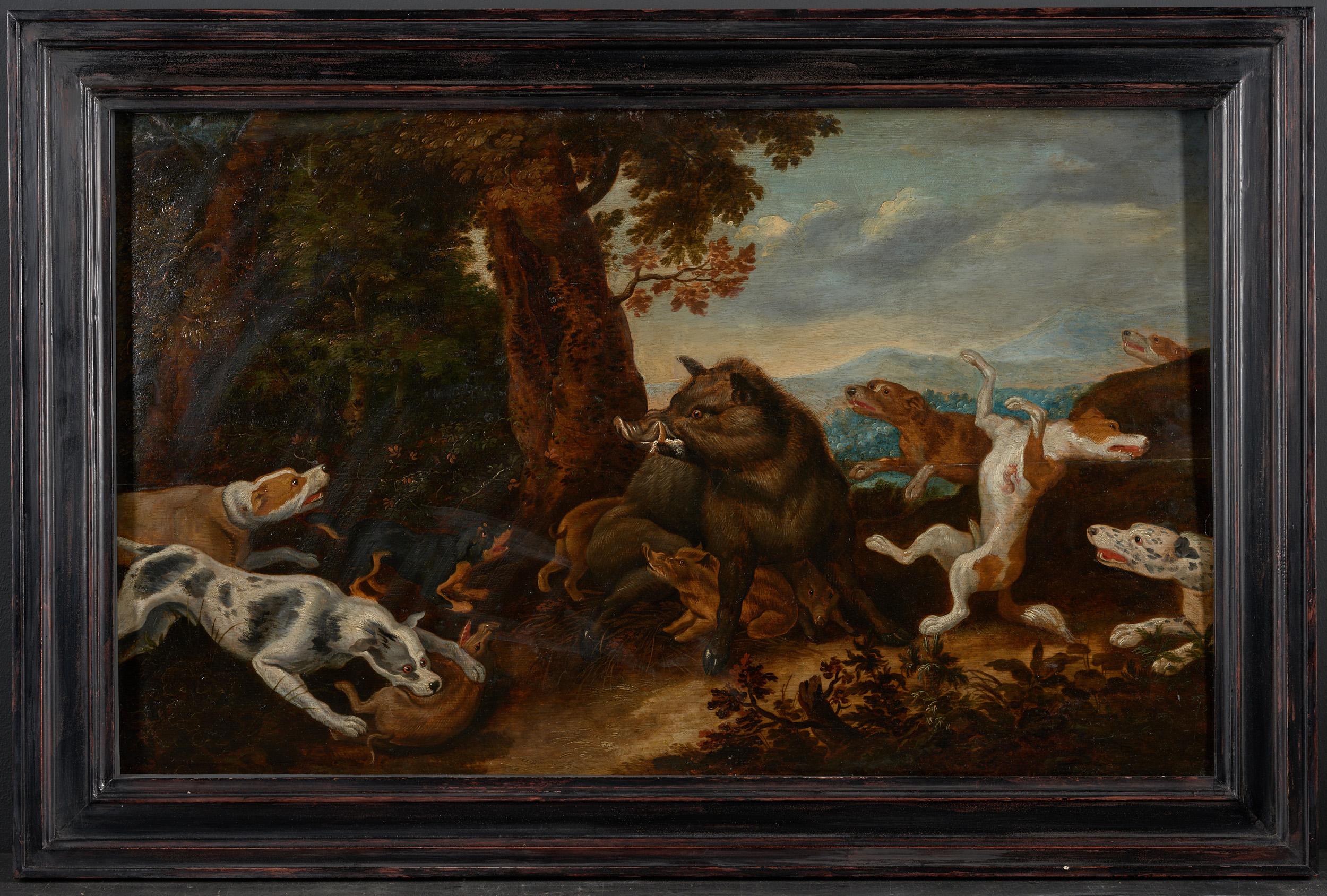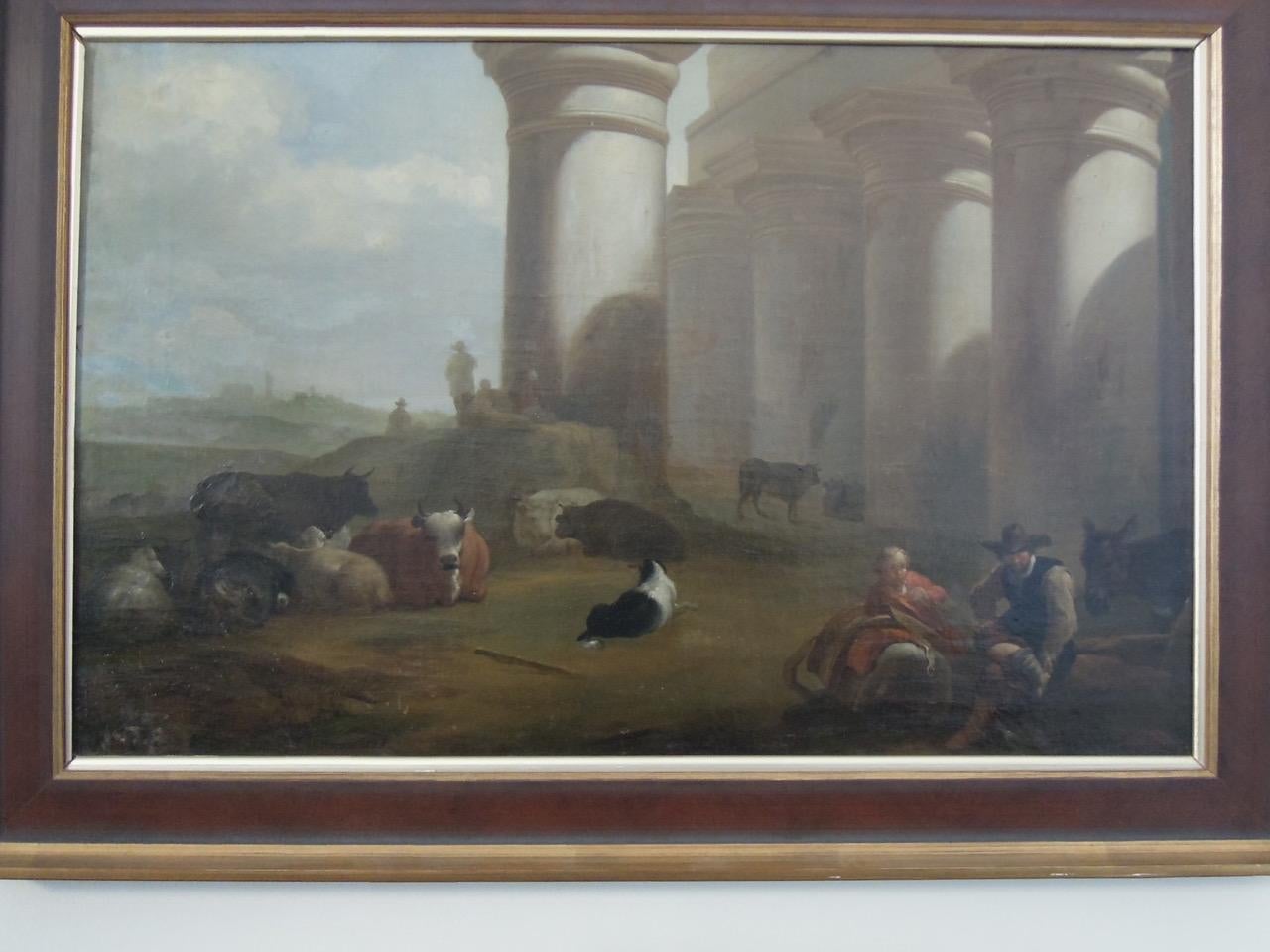Items Similar to Roaring Deer Stag, Carl Friedrich Deiker, Wetzlar 1836 – 1892 Düsseldorf, Signed
Video Loading
Want more images or videos?
Request additional images or videos from the seller
1 of 9
Carl Friedrich DeikerRoaring Deer Stag, Carl Friedrich Deiker, Wetzlar 1836 – 1892 Düsseldorf, Signed1836 – 1892
1836 – 1892
About the Item
Roaring Deer Stag
Deiker Carl Friedrich
Wetzlar, Germany 1836 – 1892 Dusseldorf, Germany
German Painter
Signature: Signed bottom right
Medium: Oil on canvas
Dimensions: Image size 58 x 81 cm, frame size 73 x 96 cm
Biography: Deiker Carl Friedrich was born on April 3, 1836 in Wetzlar. He was a Prussian animal painter. Deiker was specialised in animal genres related to hunting and wildlife. He also illustrated magazines and books on hunting.
Carl Friedrich Deiker was the son of Friedrich Deiker, a painter and drawing teacher at the high school. His older brother, Johannes Deiker, with whom he learned to draw after their father’s death in 1843, was a painter specialising in hunting scenes.
Deiker attended the Hanau drawing Academy, where he was a pupil of the director Theodor Pélissier (1794-1863), and then studied at Johann Wilhelm Schirmer’s studio in Carlsruhe.
In 1859, in the Reinhardswald forest, he collected studies for his large hunting paintings. From 1861 he had his own studio in Karlsruhe.
From 1864, he lived in Düsseldorf and painted wild boar, deer fighting, foxes, game birds.
Deiker stands in the baroque tradition of hunting and animal painters.
The painter died in Wetzlar on March 19, 1892. Today, his paintings can be found in private and public collections, including in the Cologne Museum “Dogs Chasing their Prey”.
- Creator:Carl Friedrich Deiker (German)
- Creation Year:1836 – 1892
- Dimensions:Height: 28.75 in (73 cm)Width: 37.8 in (96 cm)Depth: 3.94 in (10 cm)
- Medium:
- Movement & Style:
- Period:
- Condition:The painting is housed in high quality frame which is in excellent condition. This work is offered in ready to hang gallery condition, having been professionally cleaned and revised.
- Gallery Location:Bruges, BE
- Reference Number:1stDibs: LU2006211866762
About the Seller
5.0
Vetted Seller
These experienced sellers undergo a comprehensive evaluation by our team of in-house experts.
Established in 1998
1stDibs seller since 2022
14 sales on 1stDibs
Typical response time: 1 to 2 days
- ShippingRetrieving quote...Ships From: Bruges, Belgium
- Return PolicyA return for this item may be initiated within 14 days of delivery.
More From This SellerView All
- A Pair of Swans, Leonie Arden, Antwerp 1859 – 1904 Brussels, Belgian, SignedLocated in Bruges, BEA Pair of Swans Leonie Arden Antwerp 1859 – 1904 Brussels, Belgian Painter Signature: Signed bottom right Medium: Oil on canvas Dimensions: Image size 21,5 x 27 cm, frame size 28 x...Category
19th Century Impressionist Animal Paintings
MaterialsCanvas, Oil
- A Spring Landscape, Floris Jespers, Antwerp 1889 – 1965, Belgian, SignedLocated in Bruges, BEA Spring Landscape Jespers Floris Antwerp 1889 – 1965 Belgian Painter Signature: Signed bottom left and dated 43 Medium: Oil on canvas Dimensions: Image size 42 x 61 cm, frame size...Category
Early 20th Century Modern Landscape Paintings
MaterialsCanvas, Oil
- Schmidt Hans, Hamburg 1859 – 1950 Weimar, German Painter, Deer in a LandscapeLocated in Bruges, BESchmidt Hans Hamburg 1859 – 1950 Weimar German Painter Deer in a Landscape Signature: Signed bottom left, placed Weimar and dated 1941 Medium: Oil on canvas Dimensions: Image size 7...Category
Mid-20th Century Realist Animal Paintings
MaterialsCanvas, Oil
- Swans in the Park, Hans Volcker, Pyrzyce, Poland 1865 – 1944 Wiesbaden, GermanyLocated in Bruges, BESwans in the Park Volcker Hans Pyrzyce, Poland 1865 – 1944 Wiesbaden, Germany German Painter Signature: Signed bottom left and dated 98 Medium: Oil on canvas Dimensions: Image size 72 x 111,50 cm, frame size 84 x 120 cm Biography: Volcker Hans was born on October 12, 1865 in Pyrzyce, Poland. Hans was the son of a pastor, orphaned at a young age and raised by his grandfather. Hans Volcker was a painter of landscapes, seascapes, still lives and portraits. He also painted in watercolour and fresco techniques. In 1885, Volcker was a student of famed Norwegian realist painter Hans Fredrik Gude (1825 – 1903) at the Berlin Academy. His teacher encouraged him to travel to Scandinavia. During his study trips, he made landscape paintings of Scandinavian mountain and lakes, that brought him later great recognition. In 1891, he led his own plein air painting school. The most famous pupils were german sculptor and painter Margarethe Haeffner (1884 – 1977) and the painter Oskar Moll (1875 – 1947). With his Berlin friend painter Walter Leistikow (1865 – 1908), who was also a pupil of Gude, he shared an admiration for Max Liebermann (1847 – 1935). His acquaintance with Liebermann’s paintings furthered his stylistic development to an Impressionism. In 1894 he lived in Munich and moved to Wiesbaden in 1899, where he was active as a contemporary artist and as a member of the Art Societies, presenting Max Liebermann, Fritz Overbeck or Lovis Corinth, among others. Today, particular importance is attached to the “Dutch Secession” exhibition, featuring paintings by Vincent van Gogh and Jan Toorop. In 1912, the society showed paintings by Alexei Jawlensky...Category
Late 19th Century Impressionist Landscape Paintings
MaterialsCanvas, Oil
- Wild Boars in Winter Forest, István Szobota, Budapest 1911 – 1994 SopronLocated in Bruges, BEWild Boars in Winter Forest Szobota István Budapest 1911 – 1994 Sopron Hungarian Painter Signature: Signed bottom left and dated 1973 Medium: Oil on canvas Dimensions: Image size 6...Category
20th Century Impressionist Animal Paintings
MaterialsCanvas, Oil
- A Landscape with Two Roosters, Hoess Eugen Ludwig, 1866 – 1955, German PainterLocated in Bruges, BEA Landscape with Two Roosters Hoess Eugen Immenstadt 1866 – 1955 Langenwang German Painter Signature: Signed bottom right and dated 27 Medium: Oil on canvas Dimensions: Image size 72 x 94 cm Biography: Hoess Eugen Ludwig was born in 1866 in Immenstadt, Germany. He was a painter of landscapes and hunting scenes. He painted not only oil paintings but also watercolours and made etchings. Hoess passed the entrance examination at the Academy of Fine Arts in Munich. He was a student of master teachers and artists Kirchbach, Raupp, v. Hackl and Ritter v. Herterich. In 1889 he moved to Frankfurt and in 1891 he returned to Munich. In 1898 he went on study trips to Sweden, Austria and Italy and returned to his hometown. Two years later he had his first exhibition in Munich with paintings of hunting scenes...Category
Early 20th Century Impressionist Landscape Paintings
MaterialsCanvas, Oil
You May Also Like
- Van der Bent, Southern Landscape with woman animals, Dutch Old Master, BerchemLocated in Greven, DE17th Century Old Master, Figurative and Landscape Painting by Jan Van der Bent So far, little is known about the life and work of Jan van der Bent. He was...Category
17th Century Baroque Landscape Paintings
MaterialsCanvas, Oil
- Flemish 17th, Orpheus and Animals, Large Decorative Wall Old Master PaintingLocated in Greven, DEFlemish school, 17th century Orpheus and the animals Oil on canvas, 146,5 x 217 cm Provenance: South German private collection. On an impressive, room-filling format, this painting depicts "Orpheus and the Animals." The harp-playing Orpheus sits centrally in front of a tree whose trunk bifurcates above his head. This central tree frames with its crown the scenery towards the horizon and at the same time offers through branches the possibility for many birds to find space. The left half of the picture is characterized by a seascape, at the edge of which the ruins of a castle can be seen deep in the background. This seascape, framed by mountains on the horizon, is the only area where sky can be seen. On this side, waterfowl such as storks, swans and ducks can be seen. In the right half, the viewer looks into a deep European forest. On this right side, more land animals can be found, such as deer, rabbits and lions, among others. Orpheus wears opulent red and gold trimmed clothing, under his blue breastplate we see a white shirt. His feet are adorned by elaborate sandals. His head is surrounded by a radiant laurel wreath ("poeta laureatus"). The young man is clearly identifiable as the singer and poet of Greek mythology, Orpheus, by his harp, the laurel wreath and the animals surrounding him. Orpheus was one of the Argonauts who, under Jason, was searching for the Golden Fleece. He sang so beautifully that he even conquered the angry sea and enemies by the magic of his lyre. During the journey, Orpheus is said to have drowned out even the sirens with his singing. It is said that he was the greatest of all poets and charmed people, animals, stones and trees with his singing. In total, 51 birds and 37 different species are depicted in the painting. The animals are mostly depicted in great detail and, except for a few, can be identified. Mainly European species of animals are shown. Exceptions are the ostrich-like nandu peeking out from behind the deer, as well as the large parrot on the upper left, and the two lions. Similar is the case for the large animal directly behind Orpheus on the right. The shape of the head suggests an arctic fox from the polar regions, even though the body is much too large. The arctic fox was first described in 1555 by Olaus Magnus. However, it could also be a depiction of a brown or black bear. An unusual detail is the animal, which is relatively isolated in the right background and looks to the left. It is not clearly identifiable, but it shows certain similarities with the Australian kangaroo. This was first described by Vespucci in 1500 and further by Francisco Pelsaert in 1629. If it is indeed a kangaroo, this would be one of the earliest surviving pictorial representations. In this painting, Orpheus is accompanied by a small monkey playing a viola da gamba. This is an iconographic peculiarity. In general, this painting has some peculiarities compared to other paintings with "Orpheus and the animals". The central positioning of Orpheus is quite common, but he usually holds a lyre and is dressed in an antique style, but not as opulently. The choice of animals is also remarkable: European animals in particular are seen, hardly any exotic features, such as camels or elephants. The two lions in the right foreground are a quotation from Peter Paul Rubens and his depiction of "Daniel in the Lion's Den", which was realized in an engraving. The present painting can be classified as belonging to the Flemish School of the 17th century on the basis of its painterly and compositional conception. From the circle of Jan Brueghel the Younger are numerous representations of this Orpheus - theme, which take it as an opportunity to show as many exotic animals. There are also echoes of Spanish painters such as Juan de Arellano...Category
17th Century Baroque Landscape Paintings
MaterialsOil, Canvas
- Hunting Dog with GameBy Giacomo NaniLocated in Atlanta, GAFamous for his paintings of animals, landscapes and still lifes, Giacomo (sometimes spelled Jacopo) Nani was an Italian painter of the Baroque period. Presumably born in Naples, Nani studied under Gasparo López and Andrea Belvedere whose style Nani often imitated. Nani became famous while working in the court of Charles of Bourbon, future Charles III of Spain (1716 – 1788). His work is featured in the collections of museums worldwide, especially his hometown museum in Naples. An excellent example of his work, this painting is signed in the lower left corner "Giacomo Nani." This painting depicts a hunting dog...Category
18th Century and Earlier Baroque Animal Paintings
MaterialsOil, Canvas
- 17th C, Baroque, Hunting Scene, Wild Boar Hunt in the style of Frans SnijdersLocated in brussel, BEHunting played an essential role in the lives of princes and nobles for centuries. It was no different in the 17th century. Paintings depicting hunting scenes were hung, for example, in the hunting lodges of elites. It should be noted that the upper bourgeoisie also began to show interest in painted hunting scenes during the 17th century. In the Southern Netherlands there were a number of skilled animal painters who produced hunting scenes, including Frans Snijders, Paul De Vos, Jan Roos, Pieter Boel and Jan Fyt. Snijders knew how to render the anatomy of the animals masterfully. Also, he managed to make his animals look intelligent. He let them express a variety of feelings. His colleague, Paul De Vos, seems to have been less familiar with animal anatomy. His animals lack a kind of individuality and psychological expression. The panel shows a boar hunt with dogs. It was a prevalent theme, portrayed by Rubens, Snijders, De Vos and others. Buyers were especially interested in the showdown between animal species. The mental and physical strength appealed to their imagination. The painter of this little work has no solid knowledge of dog breeds. Due to a lack of insight into dogs' bone and muscle structure, he makes them look rather stiff. Mainly the heads have something naïve about them. It cannot be ruled out that the artist of this painting is Jan van Kessel...Category
17th Century Baroque Landscape Paintings
MaterialsCanvas, Oil, Oak
- Fine 1700's Italian Old Master Oil Painting Hunting Dogs with Game, Roman RuinsLocated in Cirencester, GloucestershireArtist/ School: Italian School, early 18th century The painting is almost certainly from the circle of the Italian Baroque painter known as 'Rosa da Napoli', Jacob Roos (Rome 1682-Na...Category
Early 18th Century Baroque Landscape Paintings
MaterialsOil
- Southern Landscape with Cows, circle of Both, Dutch 17th Century Old MasterBy Jan Dirksz BothLocated in Greven, DECircle of Andries Both, Southern Landscape with Cows. Both moved to Italy ( Rome and Venice) where is work was influenced by the warm Italian light. Decorative PaintingCategory
17th Century Baroque Animal Paintings
MaterialsCanvas
Recently Viewed
View AllMore Ways To Browse
Hunting Painting
Animal Deer
Deer Painting
Antique Animal Paintings Large
Painting Of Deer
Paintings Of Deer
Antique Hunting Painting
Antique Hunting Paintings
Large Baroque Painting
Painting With Deer
Antique Hunting Signs
Antique Stag
Animals Fighting
Dusseldorf School
Large German 19th Century Painting
Framed Deer Art
Large Hunting Paintings
Stag Art





